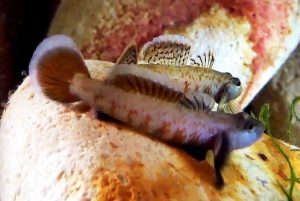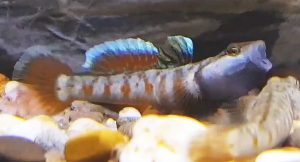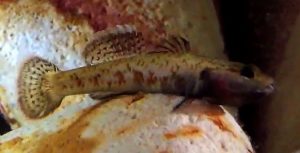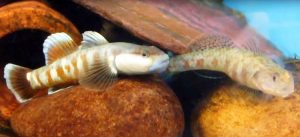The Flame Goby (Rhinogobius Zhoui) is a small freshwater species that is also known to tropical fish keeping enthusiasts as the Chinese Vermilion Goby, Scarlet Goby, or Zhou’s Scarlet Goby.
The Flame Goby is collected from one fast flowing stream that originates from the Lianhua Mountain, Haifeng County, Guangdong Province, in China.
In it’s natural habitat, the Flame Goby is frequently found with Rhinogobius duospilus (R. wui), Pseudogastromyzon laticeps, Pseudobagrus trilineatus, Zacco platypus, Parazacco spilurus, and other more well known Rhinogobius spp. species in the clean, highly oxygenated, moderately fast flowing headwaters, streams, and brooks of it’s range where it feeds on small insects, insect larvae, and aquatic invertebrates.
Flame Gobies prefer living in the shallower stretches of the riffles and runs of tributaries that are usually broken up by pools and small cascades. The substrate in these areas is typically composed of sand, gravel, smaller rocks, boulders, and areas of submerged leaf litter. Aquatic plants like Cryptocoryne crispatula var. crispatula, and Blyxa sp. are also found in their habitat.
The Flame Goby is a small, relatively peaceful, non-aggressively territorial species that grows to a max length of only 1.4″ in length. They have fused pelvic fins that form a “pelvic disc” which is a common characteristic among gobiids that allows them to cling to rocks and other submerged surfaces. This pelvic disc enables them to hold onto submerged rocks while feeding, move along the bottom against very strong currents, and even climb up waterfalls and fast flowing cascades.
The Flame Goby has a light blue/gray body color overlaid with 6 to 8 vertical scarlet-red/rust brown blotches along the flanks. The median fins are bordered with a broad, brilliant white to blue white band. Adult males are much more intensely colored than females and develop longer fins with brighter, broader, bluish to white marginal bands.
Although the color pattern, which is variable in both sexes, is a less reliable means of determining gender; adult males do not posses a black spot on the first dorsal fin and have no pigmentation on the cheek and branchiostegal membrane.
Females can be pale or brightly colored but both dorsal and caudal fins have a reddish colored marginal band.
Both sexes change their coloration quickly and frequently.
Because of it’s small size, the Flame Goby is a perfect specimen for a river nano tank.
Flame Glbies are best kept in an unheated (60-72°F) aquarium of at least 15 gallon capacity with a combination sand, gravel, small river rock, and small “boulder” substrate arranged to simulate a flowing mountain stream. Some driftwood branches, small flower pots, and ceramic pipe can be added to provide shade, hiding places, and a broken line of sight for territorial purposes. Most aquatic plants will not survive these conditions but some tropical fish keeping enthusiasts have used Anubias spp
., Bolbitis,
and Microsorum
with various degrees of success.
Flame Gobies are extremely intolerant of organic pollutants and need spotlessly clean water conditions in order to thrive. Although torrential water conditions are not necessary to keep them healthy, the addition of an oversize outside power filter, a powerhead, and an airstone along with weekly 30-50% of tank volume water changes should be considered mandatory to provide the high proportion of dissolved oxygen and water movement needed.
In a dedicated species aquarium, at least two males and three or more female Flame Gobies should be housed together or the fish become listless and inactive. Although the males will make quite a display of flaring to intimidate their fellow gobies away from their home turf, any serious damage is highly unlikely provided enough cover is placed in the tank. In fact, this species appears to require the presence of conspecifics to thrive.
The Flame Goby can be housed in a community environment with other small, peaceful species like Tanichthys, Microdevario spp., and other species that frequent the upper part of the water column. Mixing them with Caridinia, Neocaridina spp. or other Rhinogobius spp. is not recommended due to predation and possible hybridization.
The Flame Goby has been bred in an aquarium environment, but it is not an easy task.
Flame Gobies typically deposit their rather large eggs on the ceiling of a cave or crevice dug underneath a river rock in the substrate where the eggs are guarded by the male until hatched.
Use only one or two males with one or more females per male, when attempting to breed the fish, and provide multiple spawning sites for the fish to lay their eggs and defend their territories. The female will usually initiate courting when ready to spawn. Once she selects a partner, the pair will disappear from sight into a cave or flower pot where the female will deposit from 30 to 60 rather large (4mm long) eggs. When spawning is completed, the male usually forces the female from the cave until hatching occurs, usually within 24 to 48 hours.
At this point most breeders will either remove all the fish from the tank except the male guarding the eggs or remove the male along with the eggs into a separate rearing tank.
Most of the time the male will not eat the fertilized eggs but should this occur, remove the male from the eggs and place the eggs into a floating breeding net for incubation with a small powerhead or airstone
aimed at them to simulate the fanning action that the male normally provides. The tank should be kept in the dark and the eggs should not be removed from the water during the incubation process.
Fungus and bacterial issues are why successfully breeding Flame Gobies is such a challenge.
Some deteriorated Indian Almond leaves, a single alder cone with a small amount of salt, or malachite green and formaldehyde added to the tank at a rate of 3 drops per 10 liters of water will help mitigate any bacterial or fungal issues during the 13 to 21 day incubation period. These additives are not needed if the male is left to attend the eggs. When the eggs are incubated artificially, hatching tends to occur over an extended period of about 5 days or so and a few fry may have problems leaving the egg.
Because of their large yolk sac, the fry are essentially immobile until the yolk sac is completely absorbed, usually within a week. During the first few days at least, they should be kept suspended in the net with the powerhead kept in operation.
As soon as the fry are free swimming, they can be removed from the net and fed baby brine shrimp, commercial fry food
, etc. until they are able to eat larger fare. Although the fry develop slowly, changing the water every 24 to 48 hours will improve their growth rate dramatically.
In their natural habitat, Rhinogobius Zhoui feed on insect larvae, aquatic worms, small insects, and other aquatic invertebrates. In an aquarium environment they should be provided a steady diet of live or frozen bloodworms, brine shrimp, mosquito larvae, etc. Although they can be acclimated to accept dried foods, they should not be offered on a regular basis.
The Flame Goby (Rhinogobius Zhoui) is usually only available to tropical fish keeping enthusiasts through importers once a year, however, they can be purchased online from specialty dealers, wholesalers, and hobbyists on forums and auction sites when available. They are relatively “rare”, difficult to identify, and justifiably demand high prices when available for purchase.
Minimum Tank Size: 15 gallons
Care Level: Moderate
Temperament: Peaceful
Aquarium Hardiness: Hardy
Water Conditions: 66 – 76 °F, 90 – 215 ppm, pH: 7.0 – 7.8
Max. Size: 1.4”
Color Form: Scarlet, White
Diet: Omnivore
Compatibility: Nano and Commuinity tanks
Origin: China
Family: Gobiidae/Oxudercidae
Lifespan: 2 years
Aquarist Experience Level: Experienced





